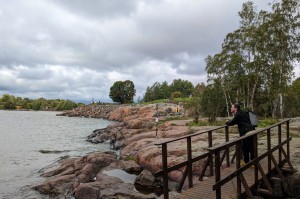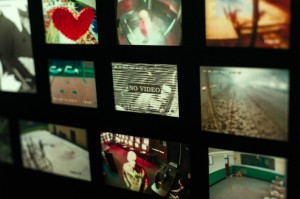Field Trip: Nantes, France – Où est Steve?
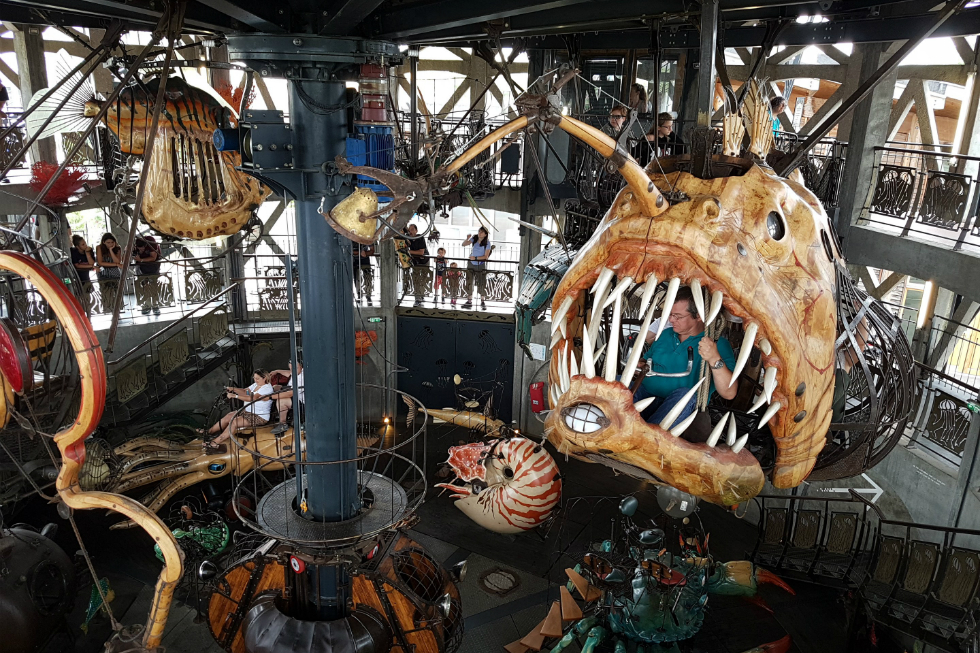
On a recent visit to Nantes to see Voyage à Nantes and the ‘Island of Machines’, the more sinister story of a missing man unfolds, reports Denise Courcoux…
I first saw it as I arrived into Nantes on the airport shuttle bus. In white spray-painted letters that filled the height of the wall alongside of the riverbank: Où est Steve? A question even my limited French could easily translate, but not understand straight away.
Formerly a major port with thriving shipbuilding and food industries, Nantes –a city situated on the Loire River in western France – is a classic example of post-industrial regeneration through culture. The factory that once produced its petits beurres biscuits is now Le Lieu Unique, a slick contemporary arts centre. The remaining dockyard cranes now tower over an island of fantastical mechanical creatures, including a 12-metre-high wooden elephant that lumbers around the site, hosing down hot, excitable crowds. This is the creation of La Machine, the company whose robotic spider La Princesse crawled over Liverpool – another port city navigating its way out of years of decline – as part of its European Capital of Culture celebrations in 2008. Liverpool’s relationship with Nantes has continued throughout the last decade with three hugely popular visits from Nantes-based Royal de Luxe’s giant marionettes.
It was due in part to this cultural kinship that I travelled to Nantes from Liverpool in July. The annual Voyage à Nantes arts festival had recently kicked off its eighth edition, with a trail sprawling over 12km, covering special exhibitions at the city’s galleries and an impressive number of commissions, mostly by French artists, in the public realm. Stand anywhere in the city centre and the likelihood is you’ll spot something incongruous. The exposed ghost of a 15th-century chimney breast, picked out in candy-bright orange, pink and green by Flora Moscovici. In a church courtyard, a deep, low hum emanates from a white boulder; one of a series of works by Cécile Beau in the Passage Sainte-Croix. The most successful commissions are those that respond to the various types of architecture and civic spaces that co-exist in a city of mixed fortunes like Nantes; subtle disruptions that draw attention to the fabric of the place.
Then there it was again, sprayed in black, curving handwriting across a footbridge: Où est Steve? I wondered to myself, Qui est Steve? Is it someone’s graffiti tag, or a cultural reference that’s alien to me, like the grinning Monsieur Chat murals I’d enjoyed spotting in Paris a few years ago? As I settled into the city, I began to notice it everywhere – mostly on pieces of white, photocopied A4 paper, taped to anything that would hold them.
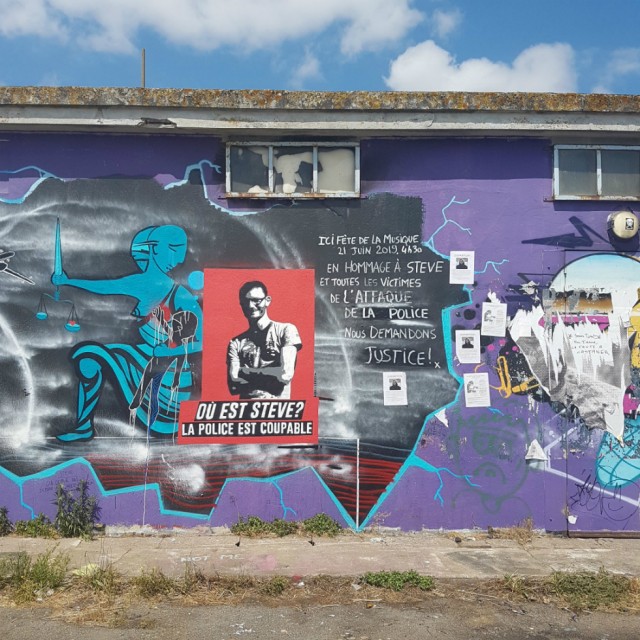
On my second afternoon, I walked along the bank of the Loire to cross the bridge over to Rezé, and Le Corbusier’s hulking Maison Radieuse: a 1950s concrete apartment block that looks better up close, when bright colour blocks pop out of its balconies, than from a distance. The riverside was hot, exposed and deserted, just a couple of minutes away from the families at Les Machines de l’Île. Along the path, between the river and the sun-scorched grass, more lettering had been sprayed. Crudely translating as I walked, it quickly became apparent that something terrible had happened here. ‘The Loire kills, so does the police.’ Chalked arrows on the ground pointed towards the expanse of brown water, with no barrier between.
A young woman was being interviewed by a reporter outside a small, solitary shed of a building. Painted on its wall was an image of Steve: a man in his twenties, tall and slightly gawky, wearing glasses, t-shirt and an uncertain smile. A typical informal snapshot of a young guy. I found an English translation of the events I’d been piecing together on a poster later on:
‘Since June 21st, Steve Maia Caniço is missing following a violent police intervention during the night of the “fête de la musique” (music festival), Quai Wilson, in Nantes. Several people were attacked (bludgeoning, LBD 40, tear gas, police dogs), with the reason that the music broadcast schedule would have been exceeded by half an hour. Twelve young people, in panic, fell in the Loire. Since then, Steve Maia Caniço, 24, has not reappeared.
‘If the methods of intervention of the Police Commissioner in charge of operations that night were challenged within the police itself, the Prefect of Loire-Atlantique has shown no empathy towards the victims. The whole political class, local as national, seems walled in silence (with few exceptions). We ask the question to all those responsible: # Where is Steve?’
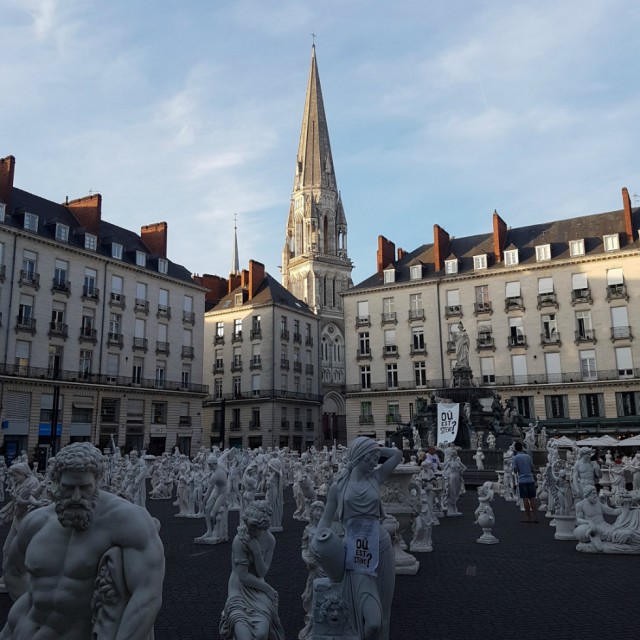
As a form of protest, Où est Steve? is both affecting and sharply effective. Nantes’ citizens are refusing to let an injustice be quietly forgotten. Où est Steve? demands answers and accountability in three short words. It is unmissable and inescapable throughout the city. During my short stay I spotted new posters being taped up by young people, mobilised and united in outrage. Bold, black text on white copier paper, in its most ubiquitous form it is easy and cheap to mass-produce; a democratic protest that anyone can participate in, whether directly affected by the events of 21 June or not. The debris of earlier, unconnected protests by the ‘gilets jaunes’ is a visible reminder of a more widespread discontent with authorities across France, most notably at the city’s McDonald’s. It serves up burgers behind boarded windows, its golden arches smashed and crowned with paint spatter.
Où est Steve? merged with the Voyage à Nantes in Place Royale, which hosts an installation by artist Stéphane Vigny. Surrounding the square’s ornate central fountain are hundreds of statues and urns; copies of classical sculptures, of the type often found in suburban gardens. It is an allusion to the fact that Place Royale is itself a replica, having been destroyed during the Second World War and then restored almost identically. Here, more Où est Steve? posters had been fixed to the fronts of many of the statues, converting them into standard-bearers for the cause. A taped-up notice nearby stressed that no artworks had been damaged in this intervention of protest into an artistic intervention of place.
Since my return from Nantes, a body, sadly, has been retrieved from the Loire; it was confirmed, more than five weeks after his disappearance, to be that of Steve Maia Caniço. An official enquiry found no link between the police’s actions and the young man’s death. A subsequent demonstration against police brutality and the perceived cover-up was met with tear gas, but Où est Steve? indicates that the questions surrounding the untimely death of Steve Maia Caniço will not be quashed or fade away in a hurry.
Denise Courcoux
Images from top: Les Machines del ’île; Où est Steve?; Stéphane Vigny, Reconstituer (feature and bottom). All images courtesy Denise Courcoux, 2019



